
type: RECENTLY BUILT CHURCH
CIRCULAR FLOORPLAN
17th CENTURY AND LATER
narga is a small island in lake tana, part of dek island, selassi = trinity, so this is the trinity church in narga.
be sure you have read the text on the axonometric view under the tag iconography.
the space between the outer arcade en the inner wall is always open to the public, for praying or meeting friends. the space behind the huge wooden doors, called the qedest (=holy place) can only be entered in the presence of the clergy.
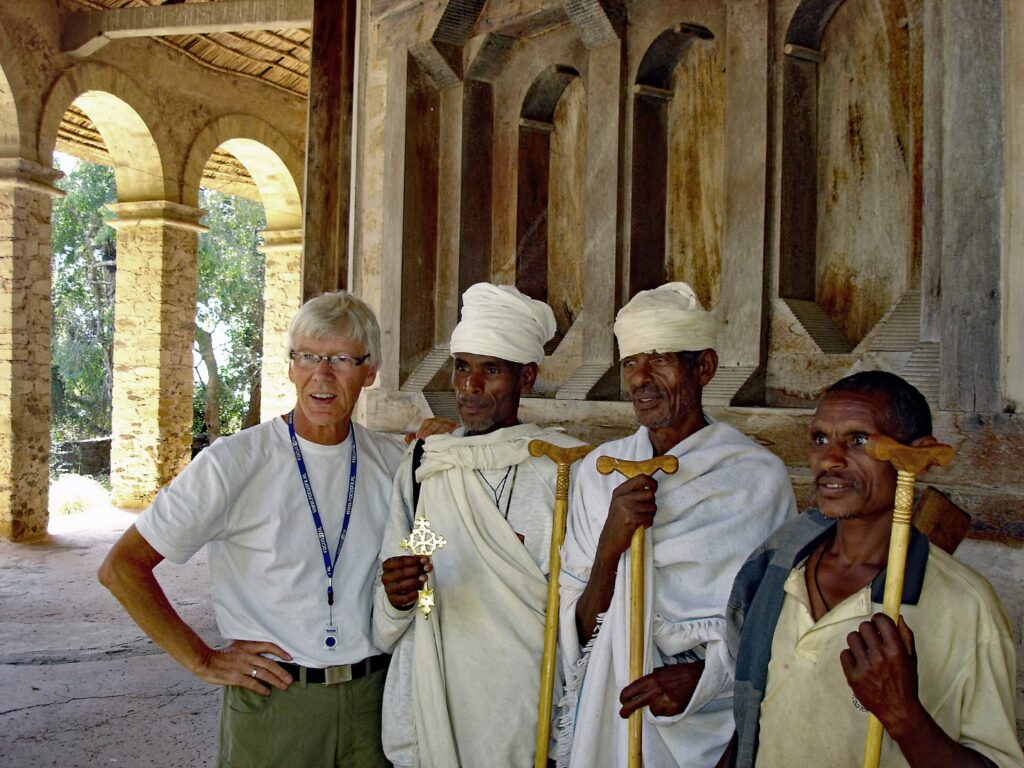
the priests are friendly, eager to share any information you wish. always bear in mind the difference between the reality they gained from the holy books and your own reality.

no fewer than eight doors give access to the qedest. they are of a rare beauty in their pure unpainted state. and so are the windows. before entering the qedest, look up and admire the skillful and refined technique of the thatched roofing. the reeds follow the rounding of the inner wall that supports the conical roof.

on entering the qedest via the west door, be aware that this door is een monoxyl, meaning it is one piece of wood, cut and flattened by hand, out of one enormous tree trunk.

inside the qedest, the combination of the painted rafters and makdas with the restful colour of the roofing, is imposing. the drum represents the first fulcrum of the conical roof, prior to the two walls.

the makdas (holy of holies) can be entered on three sides, but only by members of the higher clergy. the eastside has no doors, because there, a copy of the arc of the covenant is resting, called the tabot.
the westside has a tripartite entrance, with three beautifully painted doors. two gatekeepers, the archangels michael on the left and raphael on the right, ask our attention. both of them tell a story that is visualized under their feet.
(some sources say the angel on the right is gabriel. then the author did not or could not read the caption in amharic above the angel’s head, saying ‘qedus rufael’).
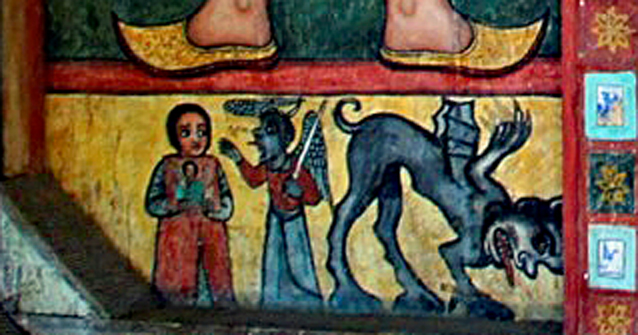
the story of euphemia
she was married to a godfearing man. on his deathbed he asked her never to forget giving alms for the needy and feasts for saint michael. she asked him to have a picture of saint michael painted in her house. he did so for her and passed away.
the devil often came unto her in various disguises, but every time she drove him away with the picture of saint michael. once he even appeared disguised as saint michael himself. he commanded her to re-marry and have a child, because a woman without a man is like a ship without a rudder. “if thou art an angel of god, where is the sign of the cross on thee?” she asked. then the real saint michael appeared and drove satan away.
when euphemia’s time had come, she distributed all her money among the poor, laid the picture of the glorious saint michael on her face and breast and died in peace.
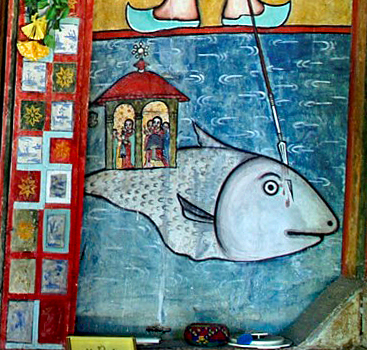
the story of saint raphael’s church near alexandria
this church, bult on a small island outside the walls of alexandria, started quaking on the very day of its consecration. the supposed island appeared to be the sand covered back of a sea monster. the devil had ordered the monster to shake the church off its back. all those present started praying for a solution and lo and behold, the archangel raphael himself came down and with a lance he fixed the monster firmly into the sea bottom. now the church was safe until…
the caliphs usurped power over the land. when raphael noticed how these people were abusing his church, he furiously pulled away his lance and ordered the monster to disappear with the barbarians into the deepest depths of the mediterranean. and so the archangel’s will was done.

my dear ethiopian friend and guide adera mengist, is looking up at the paintings of
the passage through the red sea.
ethiopia is situated quite close to the red sea coast. every orthodox ethiopian is familiar with this story. moses was the leader of the jews, roaming about the egyptian desert for forty years, without finding the way out to the promised land of palestine. they were punished by the hand of god for worshipping a golden calf instead of god himself. when they had served their sentence, moses received a message, saying he could seperate and join the waters of the red sea by beating them with his his staff. and so he did!
top left in this door moses is beating the waters in order to join them again. his sister miryam, beating the big drum, is leading the women. bottom right her brother and priest aäron, shaking the sistrum, is leading the men. the crowned pharao on horseback is swallowed up half way, while his infantry has disappeared almost completely under the waves. to our perplexity we even notice several old testament rifle butts sticking out of the water! (exodus 14:13)
this biblical episode is found on numerous church doors, because moses is also the person who received the arc of the covenant from god’s hands, on the sinai mountain. this arc contains two stone slabs with the ten commandments. a copy thereof, called the tabot, is resting in every makdas in every single church. that is why the makdas is called the holy of holies. the original arc with the original ten commandments is kept in the sinai church at aksum. so they say.
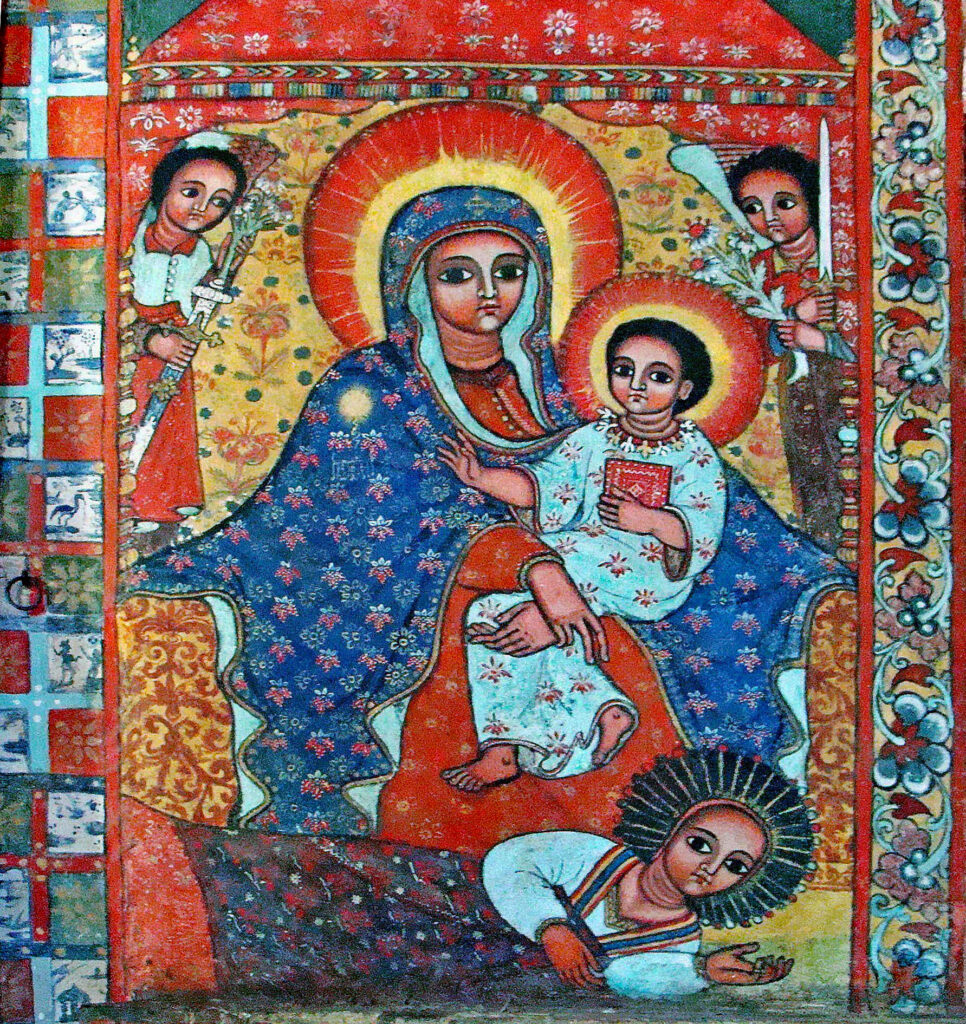
a colorful painting of the madonna and child is found to the right of the three doors. the prostrated woman at the feet of saint mary is known as queen mentewab, meaning ‘how beautiful she is’. when her husband bekafa died, she became queen-regent (1730). seven years later she leaves her palace in gonder searching for a location to build a church. she found it in narga, where already a new palace was being built on her behalf. so she is also the founder of this selassi church.
her court maintained trading contacts with both the east and the west. the abundant ornamentation in the paintings of the narga selassi church must be attributed to the richly painted persian and chinese fabrics, worn by mentewab and her courtiers. she originates from the province of quara, so the over-decorated style of this period is called the quara style. especially the two archangels on the doors in their flowery garbs, their wide hoses and silvery slippers, comply with this eastern look.
characteristic of the quara style is also the modelling of the young round faces and hands by means of a soft transition from dark to light (sfumato). the decorative patterns, mainly flowers, do not follow the folds in the fabrics. they are painted flat on the clothes, sometimes in straight lines.
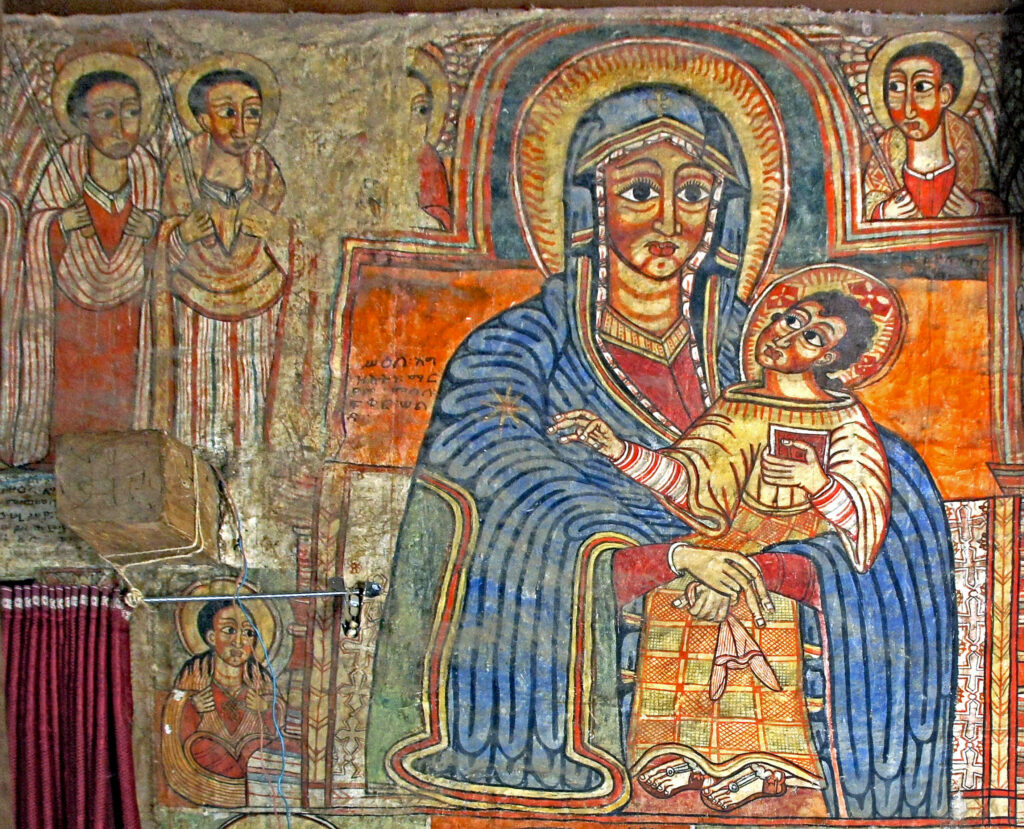
if we compare the quara style madonna with the madonna in the 17th century sina maryam in gorgora, the differences are striking. the mask like shadows in the faces and in mary’s neck follow a fixed formula, dehumanizing the human body. the quara style figures look more natural, though the eyes are still oversized and staring.


on the east side of the makdas there is a four-part window frame with shutters. three of them are filled with mary and archangels, protecting young girls. the fourth one shows thomas, the unbelieving apostle. he is putting his finger in the side wound of jesus. now he could believe that jesus had really risen from the grave.
note the grid like ornaments in the three window posts, they also occur in the painted rafters, in the tripartite doors and in the portrait of the madonna. if we zoom in we notice that the white squares show paintings of animals, plants and scenes from daily life. in some publications their origin is related to portuguese tiles, based on the long-term relationship with portugal. the same tiles, not painted but the real ones, were used in the gondarine palace of queen mentewab. there is also a second interpretation concerning these tiles.
a well known french anthroplogist, marcel griaule, leadng an expedition between 1931 and 1933, spent considerable time in gonder. he visited the ruins of queen mentewabs’ palace, where he picked up some fragments of blue tiles. back in paris these fragments were recognized as dutch blue delftware, now kept in the musée de l’homme in paris. the queen had probably bought them in batavia, capital of the former duch colonies in indonesia. apparently she intended to decorate also her palace and church in narga with these tiles. but there were not any left, so she had them painted this time.
from here their fame has spread to many other churches in the tana district and elsewhere. being dutch I felt the urge to pay attention to this discovery of marcel griaule. it feels kind of good to know that mentewab beautified her palace with the same tiles as we did in our humble kitchen.

we owe her majesty mentewab our gratitude for being the initiator of this interesting and valuable building. the narga selassi church is known to be the most richly decorated church in and around lake tana. a must see for art lovers. the boat trip will take you three ours to get there and three more to come back. that is long for a day trip but more than worth while.
